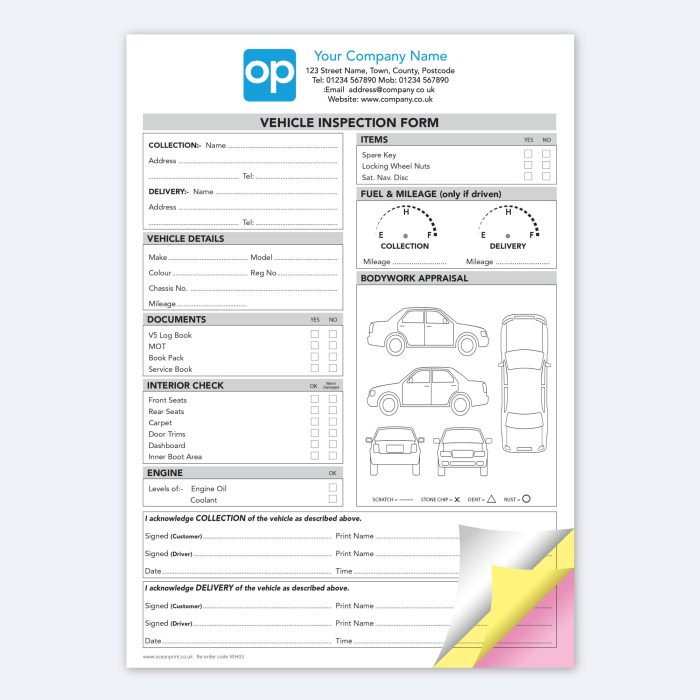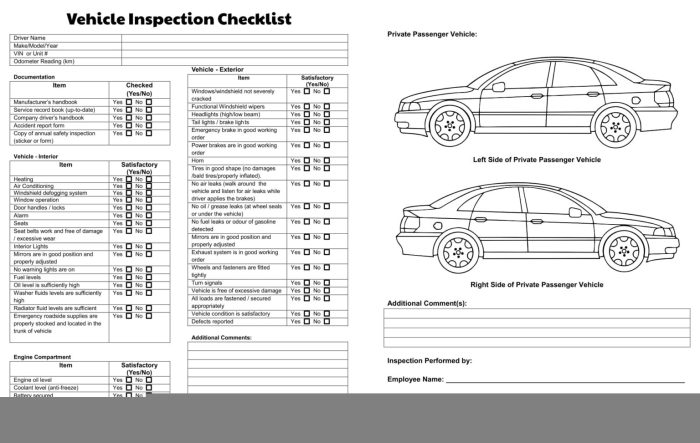Vehicle inspection checklist sets the stage for this essential guide, presenting a comprehensive look at why regular inspections are crucial for maintaining vehicle performance and safety. By adhering to a well-structured checklist, vehicle owners not only comply with legal obligations but also safeguard themselves and others on the road. This article explores the various components and types of inspections, ensuring that everyone understands the importance of a meticulous approach to vehicle care.
Get the entire information you require about Coupe vs convertible sports cars on this page.
From fluid levels to tire conditions, each element plays a significant role in the overall functionality of a vehicle. The insights provided here will empower you with the knowledge needed to conduct thorough inspections, avoid common pitfalls, and embrace technology to enhance accuracy in your vehicle maintenance routine.
For descriptions on additional topics like Audi RS3 Sedan, please visit the available Audi RS3 Sedan.
Importance of Vehicle Inspection Checklists
Vehicle inspection checklists are essential tools in ensuring the safety and reliability of vehicles. These checklists help in identifying potential problems before they escalate into major issues, thereby promoting regular maintenance and enhancing overall vehicle performance.
Benefits of Using a Vehicle Inspection Checklist
A vehicle inspection checklist provides numerous benefits, including:
- Enhances safety by identifying critical issues that could lead to accidents.
- Improves vehicle performance through regular maintenance, ensuring optimal functionality.
- Helps in maintaining compliance with legal requirements that vary by region.
Legal Requirements for Vehicle Inspections
In many regions, vehicle inspections are mandated by law. These regulations often require periodic checks to ensure vehicles meet safety and environmental standards. Failure to comply can result in fines and penalties.
Common Issues Detected Through a Thorough Checklist
A well-structured vehicle inspection checklist can uncover various common issues, including:
- Brake wear and performance problems.
- Fluid leaks, which can indicate serious engine or transmission problems.
- Tire condition and pressure discrepancies that may lead to blowouts.
Components of a Vehicle Inspection Checklist
A comprehensive vehicle inspection checklist should include several critical components to ensure thorough evaluation.
Comprehensive List of Items
The following items must be included in a vehicle inspection checklist:
- Exterior lights: headlights, brake lights, turn signals, and hazard lights.
- Tires: tread depth, pressure, and overall condition.
- Fluid levels: oil, coolant, brake fluid, and transmission fluid.
- Brakes: pads, rotors, and functionality.
- Wipers and washers: condition of blades and fluid levels.
Importance of Checking Fluid Levels
Fluid levels are crucial for vehicle performance. Insufficient fluids can lead to overheating, braking failures, and poor engine lubrication, ultimately reducing the vehicle’s lifespan and increasing repair costs.
Relevance of Tire Condition and Pressure
Tire condition and pressure significantly impact vehicle safety and fuel efficiency. Properly inflated tires improve handling and reduce the risk of blowouts, while worn tires can lead to loss of traction.
Types of Vehicle Inspections: Vehicle Inspection Checklist
Vehicle inspections can be categorized into several types, each serving a unique purpose.
Pre-trip Inspections versus Routine Maintenance Inspections
Pre-trip inspections are conducted before embarking on a journey, focusing on critical safety elements, while routine maintenance inspections are scheduled checks that ensure ongoing vehicle performance and condition.
Personal Vehicle Inspections and Commercial Vehicle Requirements
Personal vehicle inspections generally focus on safety and compliance with local laws, while commercial vehicles often have stricter regulations that include more frequent inspections and specific safety standards.
Seasonal Inspections

Seasonal inspections are vital for preparing vehicles for different weather conditions. Preparing a vehicle for winter conditions, for example, may involve checking the battery, antifreeze levels, and tire tread.
Step-by-Step Guide to Conducting an Inspection
Conducting a vehicle inspection systematically ensures thoroughness.
Systematic Approach Using a Checklist
Start by gathering your checklist. Divide the inspection into categories such as:
- Exterior: body condition, lights, and tires.
- Interior: dashboard instruments, safety features, and comfort controls.
- Under the hood: engine condition, fluid levels, and battery health.
Documenting Inspection Results
Documenting the results of each inspection is crucial for future reference. Create a record of findings and any corrective actions taken to ensure accountability and track recurring issues.
Technology in Vehicle Inspections
Modern technology plays a significant role in enhancing the vehicle inspection process.
Mobile Apps Assisting in Vehicle Inspections
There are various mobile apps available that assist in conducting vehicle inspections. These apps can simplify the checklist process, provide reminders for upcoming inspections, and even allow for the digital documentation of findings.
Role of Digital Checklists
Digital checklists enhance the inspection process by making it easier to update, share, and store information. They also reduce the chances of human error, ensuring a more reliable inspection.
Improving Accuracy and Accountability
Technology improves accuracy in inspections by providing tools for precise measurements and diagnostics. This accountability reduces the likelihood of overlooking critical areas during inspections.
Common Mistakes During Vehicle Inspections
Even experienced inspectors can make mistakes that may lead to overlooked issues.
Frequent Errors Made During Inspections

Common errors include:
- Rushing through the checklist.
- Neglecting to check all vital fluids.
- Failing to document findings properly.
Consequences of Overlooking Specific Items
Overlooking specific inspection items can lead to severe safety risks, increased repair costs, and can even affect the vehicle’s compliance with legal standards.
Training and Resources for Vehicle Inspections
Training is essential for individuals conducting vehicle inspections to ensure they are knowledgeable and competent.
Importance of Training
Proper training helps inspectors understand what to look for and how to conduct thorough inspections. It equips them with the skills necessary to identify potential issues effectively.
Resources for Improving Inspection Skills
Several resources are available for those looking to enhance their inspection skills, including:
- Books on vehicle maintenance and inspection techniques.
- Websites offering online courses on automotive standards.
- Workshops and seminars on the latest industry practices.
Staying Updated on Industry Standards
It is crucial for inspectors to stay informed about changing regulations and best practices in vehicle inspections to ensure compliance and safety.
Case Studies and Real-Life Examples
Real-life examples highlight the importance of thorough vehicle inspections.
Preventing Accidents or Breakdowns

Proper inspections have been known to prevent numerous accidents by identifying critical issues before they become dangerous. For instance, a well-timed brake inspection could reveal worn pads, avoiding potential failure during driving.
Case Studies of Failed Inspections
Vehicles that fail inspections can face severe consequences, including increased repair costs and legal penalties. These case studies demonstrate the importance of adhering to inspection protocols.
Testimonials on the Value of Checklists
Professionals in the automotive industry frequently testify to the value of vehicle inspection checklists, emphasizing their role in enhancing safety and ensuring vehicle reliability.
Last Recap
In conclusion, a vehicle inspection checklist is not just a bureaucratic formality; it is a vital tool that can prevent accidents and extend the life of your vehicle. By understanding its components, embracing technology, and committing to continuous education, you can ensure that your vehicle remains in optimal condition. Remember, thorough inspections pave the way for safer journeys and peace of mind on the road.